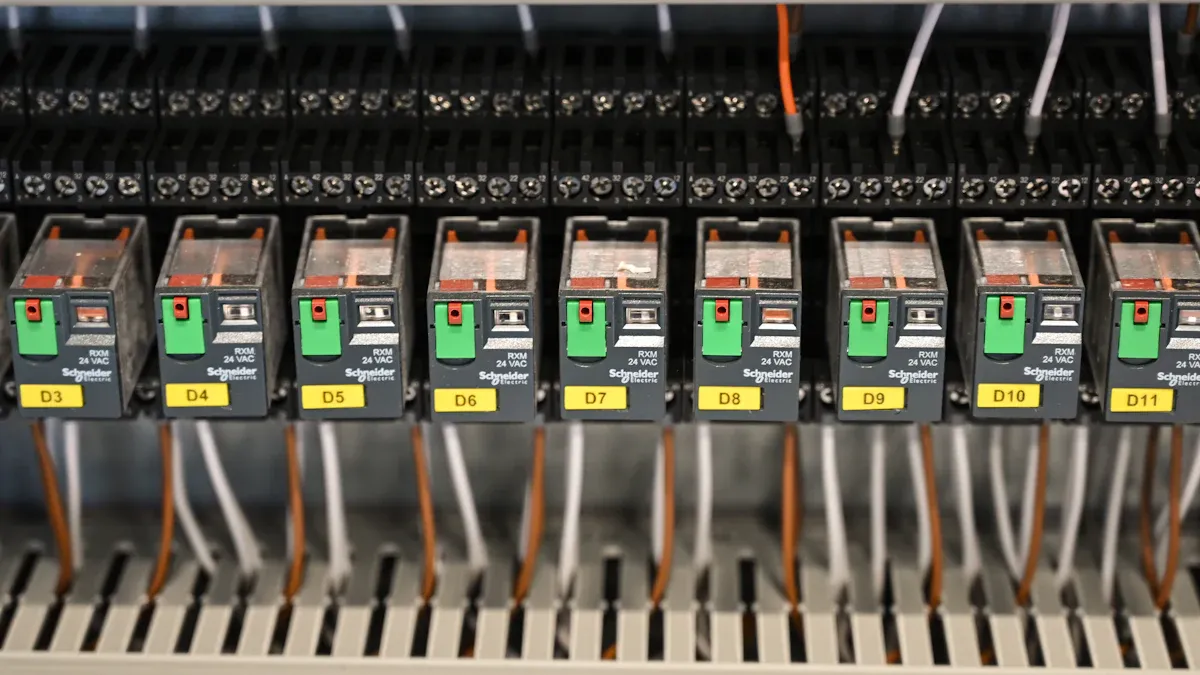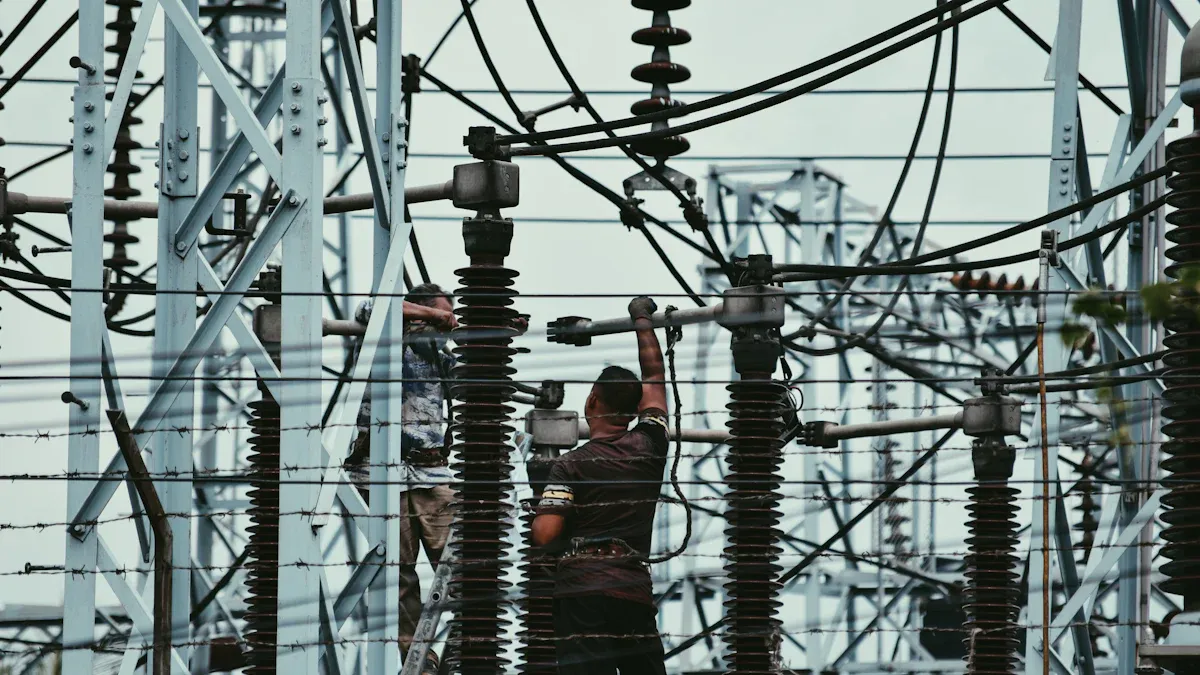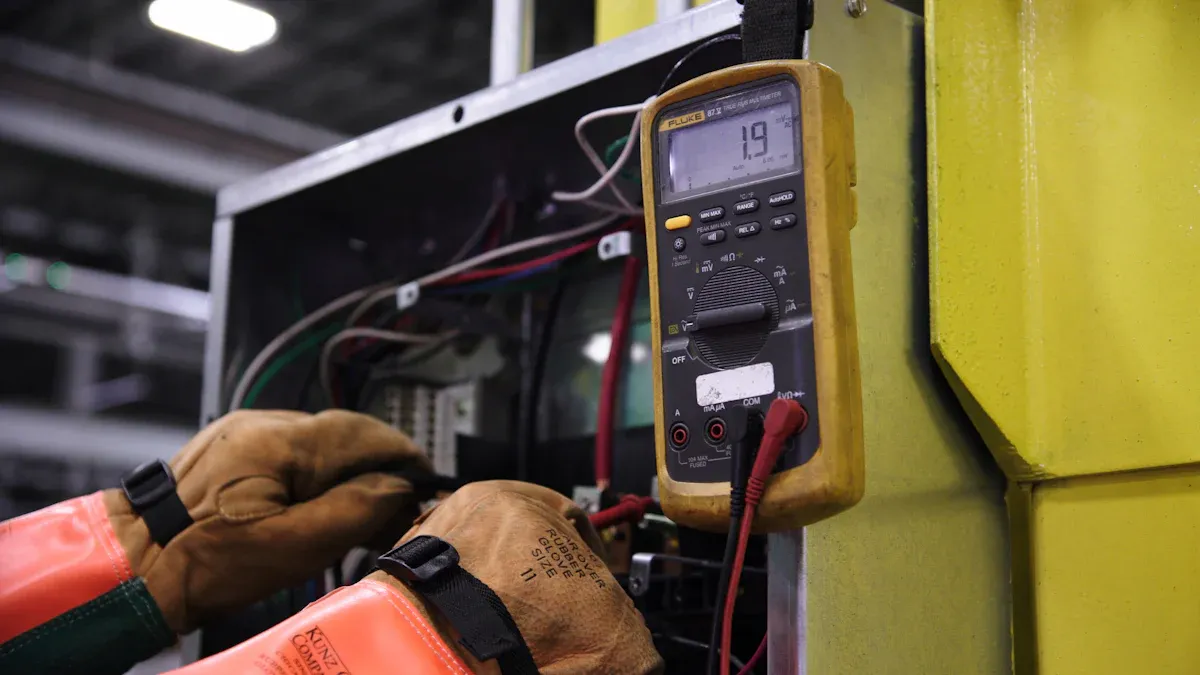Step-by-Step Guide to Installing and Maintaining a Power Distribution Unit

A power distribution unit (PDU) shares electricity to many outlets. It takes power from one source and spreads it out. PDUs are very important for managing power well. They are used in places like data centers and server rooms. Metered PDUs let you check power use instantly. This helps you find ways to save energy. Some PDUs can be checked from far away. This makes them useful for remote work setups. In 2022, the PDU market was worth $3.9 billion. This growth came from the need for energy-saving tools and more data centers by companies like Google and Microsoft. Installing and taking care of your PDU keeps it safe and working well for a long time.
Key Takeaways
Collect all tools you need before starting. You will need a screwdriver, cable ties, and a voltage tester. Being ready makes the job easier.
Make sure the PDU works with your electrical system. Check your devices' power needs and match them to the PDU's capacity to avoid problems.
Be safe while installing. Turn off the power, use tools with insulation, and keep the area dry to stop accidents.
Check and clean your PDU often to keep it working well. Dust can make it too hot, so clean it regularly to avoid issues.
Use smart PDUs to watch power use. Checking things like voltage and current helps find problems early and saves energy.
Preparation for the Installation Process
Tools and Equipment Needed
Before setting up a PDU, gather all needed tools. This makes the process faster and easier. You will need a screwdriver, cable ties, and a voltage tester. A cable management kit is helpful for organizing wires. Make sure your rack enclosure fits the PDU properly. Use the mounting brackets that come with the PDU to secure it. Labeling tools like tags or markers help keep cables organized. Having everything ready avoids mistakes and saves time during setup.
Ensuring Compatibility with Your Electrical System
Check if your electrical system works with the PDU you chose. First, look at the power needs of your devices. Match these needs to the PDU's power capacity. For example, if your devices need 120V, the PDU must provide 120V too. Measure your rack enclosure to ensure the PDU fits. A vertical 0U PDU saves space but needs a compatible rack. Also, check the PDU's plug type to match your power outlet. Compatibility prevents problems and keeps everything working well.
Safety Precautions to Follow
Safety is very important when working with electricity. Always turn off the power before starting the setup. Use tools with insulation to avoid electric shocks. Keep the area dry and free of clutter. When placing the PDU, make sure it doesn’t block airflow or other equipment. Secure cables to avoid tripping hazards. After setup, test the PDU with a voltage tester to ensure it works. These steps protect you and your equipment from harm.
Step-by-Step Installation Process

Positioning and Mounting the Rackmount Power Distribution Unit
Start by picking a spot for the rackmount PDU. Most experts suggest placing it at the back of the rack. This makes it easier to reach outlets and keeps cables tidy. Secure the PDU with the brackets that come with it. These brackets hold the unit steady and stop it from moving.
Next, plug your devices into the PDU. This helps spread the power load evenly across the outlets. Use cable ties or a kit to organize the cords neatly. Neat cables improve airflow and prevent accidental unplugging. Following these steps gets your PDU ready for the next stage.
Connecting the PDU to the Power Source
After mounting, connect the PDU to the power source. Find the main input breaker first. This part links incoming power and powers the transformer. Check if the PDU’s plug fits the outlet to avoid problems. Once confirmed, plug the PDU into the outlet.
Some PDUs have extra features like surge protection and power meters. Surge protection shields devices from sudden power spikes. Meters let you track how much power is being used. Double-check all connections to make sure they are secure before moving on.
Initial Testing and Grounding
Testing and grounding keep the PDU safe and working well. Use a voltage tester to check if the power source works. Turn on the PDU and see if all devices get power. This test helps find problems early.
Grounding the PDU is also very important. It lowers the chance of shocks and protects against power surges. Most PDUs include grounding steps in their manuals. Follow these instructions to finish the setup. Testing and grounding ensure your PDU works safely and reliably.
Configuring the Data Center PDU
Setting Up Power Distribution Preferences
Setting up power preferences helps your PDU work better. First, check the power needs of your devices. Group devices with similar power needs together. This stops energy waste and avoids overloading. For example, connect high-power servers to strong outlets. Low-power devices can share outlets with similar equipment.
Good power settings save energy and improve efficiency. A study showed using a power load algorithm cut energy use by 15.5%. This proves the importance of matching PDU settings to your needs.
Switching to advanced power systems can save even more energy. The table below shows the benefits:
Metric | Value |
|---|---|
Power System Change | 12 V to 48 V |
Current Draw Reduction | 4 times less |
Distribution Loss Reduction | 16 times less |
Annual Energy Savings | 1.4 million kWh |
CO2 Emissions Reduction | Over 21 million pounds |
Cost Savings | $98,000 |
Setting up power preferences saves energy and helps the environment.
Configuring Network and Monitoring Features
Modern PDUs can track power use in real time. Connect the PDU to your network using Ethernet or Wi-Fi. Open the PDU’s interface on a browser or software to start monitoring.
Set up metrics like current, voltage, and power use. These show how well your PDU works. The table below lists key metrics:
Metric Type | Description |
|---|---|
Current | Tracks electric flow through the PDU. |
Voltage | Shows electric potential difference across the PDU. |
Power | Measures energy use or production rate. |
Apparent Power | Total power flow in an AC circuit. |
Crest Factor | Ratio of peak current to RMS current. |
Reactance | Resistance to current change in AC circuits. |
Power Factor | Efficiency of power use. |
Accumulated Energy | Total energy used over time. |
Harmonic Distortion | Distortion in current or voltage waveforms. |
Distortion Power Factor | Efficiency loss from harmonic distortion. |
Monitoring these metrics helps fix problems and improve power use. For example, tracking distortion can show power quality issues. Setting up network features keeps your PDU running well.
Adjusting Load Balancing and Power Limits
Balancing loads and setting limits keeps power steady and safe. First, check the power needs of your devices. Spread the load evenly across the PDU outlets. Many PDUs have tools to make this easier.
Set power limits for each outlet to improve efficiency. Give higher limits to important servers. Limit non-essential devices to save power during busy times.
Studies show balancing loads and setting limits works well:
Transformers handled 80 kW during peak times, not 350 kW.
Voltage stayed above 0.90 p.u., not below 0.7 p.u.
Managing charging points cut peak demand by 46.7% for international EVs.
These steps improve PDU performance, save energy, and boost reliability.
Maintenance Tips for Long-Term Use

Regular Inspection and Cleaning
Taking care of your PDU starts with regular checks and cleaning. Dust and dirt can build up, making it less efficient and causing it to overheat. Plan regular maintenance to avoid breakdowns and make your equipment last longer. Watching its condition helps you fix problems early and keep it running well. Checking it on-site ensures it stays reliable and catches issues quickly.
Tip: Make a cleaning plan to stop dirt buildup. Write down cleaning steps and check if they work often.
Maintenance Type | What It Means | Why It Helps |
|---|---|---|
Preventive | Fixing things based on time or use | Stops breakdowns, makes equipment last longer |
Predictive | Fixing based on how it’s working | Cuts surprise problems, keeps it working better |
On-site Condition | Checking and cleaning regularly | Keeps it reliable, finds problems early |
Cleaning also means checking for leftover dirt and seeing if cleaning methods work. This keeps your PDU clean and running smoothly.
Monitoring Power Usage and Performance
Watching how much power your PDU uses is very important. Tools like PRTG check power, voltage, and currents all the time. These tools find problems fast so you can fix them quickly. Smart rPDUs collect power data from racks and devices. This lets you watch and control them from far away.
Note: Use PDUs with monitors to save energy and get alerts about power or environment issues.
Monitoring Tool | What It Does |
|---|---|
PRTG | Watches power, voltage, and currents; finds problems fast. |
Smart rPDUs | Collects power data; lets you control it remotely. |
Remote Monitoring | Saves energy; tracks daily power use for better control. |
Monitored PDUs | Protects circuits; sends alerts for power and environment problems. |
By keeping an eye on these, you can stop power issues and keep things running well.
Replacing Components and Updating Firmware
Parts in your PDU can wear out or stop working over time. Changing these parts quickly keeps your system working well. Look for loose wires or broken outlets. Replace bad parts to stop power problems.
Updating firmware is also very important. Updates fix bugs and make the PDU work better. Many modern PDUs make updates easy to do. Keeping firmware updated helps it work with new tech and improves how it runs.
Tip: Do firmware updates when fewer people are using power to avoid interruptions.
By replacing old parts and updating firmware, your PDU will last longer and work better.
Setting up and taking care of a PDU helps manage power well. Follow steps like placing, plugging in, and grounding the unit. Clean and check it often to keep it working properly.
Key Benefits of Good PDU Care:
New PDUs track energy use and find problems fast.
Remote control and power tracking make them more effective.
Benefit | What It Means |
|---|---|
Efficiency | Three-phase PDUs share power better than single-phase ones. |
Cost Savings | Using less energy lowers electricity costs. |
Operational Reliability | Better monitoring keeps systems running smoothly. |
Using these tips protects your devices, saves power, and makes your PDU last longer.
FAQ
What does a power distribution unit do?
A power distribution unit shares electricity with many devices. It helps manage power well and stops overloads. You can use it in server rooms, data centers, or places needing organized power.
How do you set up a rackmount power distribution unit?
To set up a rackmount PDU, attach it to the rack with its brackets. Plug it into the power source and connect your devices. Follow the steps carefully to keep it safe and working right.
What safety steps should you follow with a PDU?
Always turn off power before starting. Use tools with insulation and keep the area dry. Ground the PDU properly and don’t overload outlets. These steps keep you and your devices safe.
How often should you check and clean your PDU?
Check and clean your PDU every three to six months. Look for dust, loose wires, or broken parts. Watching power use and updating firmware also helps keep it working well.
Can a data center PDU save energy?
Yes, a data center PDU saves energy by tracking power use and balancing loads. Features like network monitoring and power limits reduce waste and improve performance.
See Also
Essential Insights Into Telecom Power Supply Systems For Beginners
Ensuring Consistent Power Supply For Telecom Cabinets Effectively
Understanding ESTEL PDUs And Their Importance In Data Centers
Complete Overview Of Wiring And Cable Choices For Telecom Cabinets
Selecting And Installing Telecom Cabinets On Poles: Safety Tips
CALL US DIRECTLY
86-13752765943
3A-8, SHUIWAN 1979 SQUARE (PHASE II), NO.111, TAIZI ROAD,SHUIWAN COMMUNITY, ZHAOSHANG STREET, NANSHAN DISTRICT, SHENZHEN, GUANGDONG, CHINA
